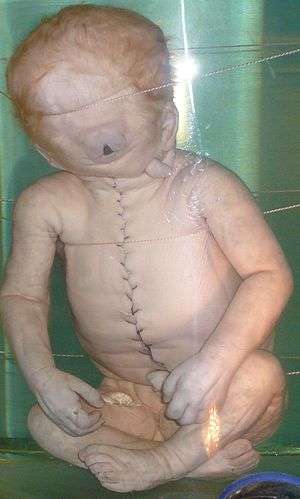Cyclopia
| Cyclopia | |
|---|---|
 | |
| Classification and external resources | |
| Specialty | medical genetics |
| ICD-10 | Q87.0 |
| ICD-9-CM | 759.89 |
Cyclopia (also cyclocephaly or synophthalmia) is a rare form of holoprosencephaly and is a congenital disorder (birth defect) characterized by the failure of the embryonic prosencephalon to properly divide the orbits of the eye into two cavities. Its incidence is 1 in 16,000 in born animals and 1 in 200 in miscarried fetuses.[1][2]
Presentation
Typically, the nose is either missing or replaced with a non-functioning nose in the form of a proboscis. Such a proboscis generally appears above the central eye, or on the back, and is characteristic of a form of cyclopia called rhinencephaly or rhinocephaly.[3] Most such embryos are either naturally aborted or are stillborn upon delivery.
Although cyclopia is rare, several cyclopic human babies are preserved in medical museums (e.g. The Vrolik Museum, Amsterdam).[4]
Some extreme cases of cyclopia have been documented in farm animals (horses, sheep, pigs, and sometimes chickens). In such cases, the nose and mouth fail to form, or the nose grows from the roof of the mouth obstructing airflow, resulting in suffocation shortly after birth.[5]
Causes
Genetic problems or toxins can cause problems in the embryonic forebrain-dividing process.[6] One highly teratogenic alkaloid toxin that can cause cyclopia is cyclopamine or 2-deoxyjervine, found in the plant Veratrum californicum (also known as corn lily or false hellebore). The mistake of ingesting Veratrum californicum while pregnant is often because hellebore, a plant with which it is easily confused, is recommended as a natural treatment for vomiting, cramps, and poor circulation, three conditions that are quite common in pregnant women.[7] Cyclopia can occur in the womb when certain proteins are inappropriately expressed[8] and causes the brain to stay whole instead of forming into two distinct hemispheres, which also means one optic lobe and one olfactory lobe resulting in one eye.[9]
SHH (Sonic Hedgehog Gene Regulator, named after the effects a mutation in the gene had on the forming embryo of fruit flies studied by scientists; a spiky appearance under a microscope, similar to that of its video game character namesake) is involved in the separation of the single eye field into two bilateral fields. Although not proven, it is thought that SHH emitted from the prechordal plate suppresses Pax6 which causes the eye field to divide into two. If the shh gene is mutated, the result is cyclopia, a single eye in the center of the face (Gilbert, 2000).
Notable cases
- A British description from 1665 of a colt apparently suffering from cyclopia reads:
First, That it had no sign of any Nose in the usual place, nor had it any, in any other place of the Head, unless the double Bagg CC that grew out of the midst of the forehead, were some rudiment of it. Next, That the two Eyes were united into one Double Eye which was placed just in the middle of the Brow.[10]
- On 1 March 1793 a 46-year-old woman in Boalts Torp, Glimåkra, Sweden gave birth to a child with cyclopia that died after 2 hours. The child was 35 cm long, its face without nose and nostrils, the lidless eye with no eyebrow sat raised on the middle of the forehead like a large blueberry. The wrists were somewhat crooked as well as the right foot which was completely crooked and bent inwards. It was not clear whether it was a boy or a girl but it was believed to be the former.[11]
 A Swedish description from 1793 of a newborn with cyclopia
A Swedish description from 1793 of a newborn with cyclopia - On December 28, 2005, a kitten with cyclopia, "Cy", was born in Redmond, Oregon, United States and died about one day after birth.[12]
- In 2006, a baby girl in India with cyclopia was born. Her only eye was in the center of her forehead. She did not have a nose and her brain was fused into a single hemisphere.[13] The child died 1 day after her birth.[14]
- In 2011 a cyclops shark fetus was discovered in the body of a caught shark in Mexico, with no discernible nose and one giant eye. The unborn fetus was turned over for medical studies.[15]
- On October 10, 2012, a small kitten was born. Its eye was in the center of the forehead and there was no developed nose to be found. The small cat died shortly after it was born. It was nicknamed Cleyed the Cyclops.[16]
See also
References
- ↑ Taber's Cyclopedic Medical Dictionary, ISBN 0-8036-0654-0
- ↑ Leroi, Armand Marie Mutants: On Genetic Variety and the Human Body, p.73. ISBN 978-0142004821
- ↑ Dark, Graham (2007). Rhinocephaly. In Online Medical Dictionary. Retrieved July 23, 2008.
- ↑ "Vrolik Museum, Department of Anatomy And Embryology, University of Amsterdam".
- ↑ "Feline Medical Curiosities: Facial Deformities". Messybeast.com. 2007. Retrieved 2008-11-29.
- ↑ "Cyclopia definition". Medical Dictionary. MedTerms. Retrieved 2008-11-29.
- ↑ "Teratology Society".
- ↑ Erich Roessler; Elena Belloni; Karin Gaudenz; Fernando Vargas; Stephen W. Scherer; Lap-Chee Tsui & Maximilian Muenke (1997). "Mutations in the C-terminal domain of Sonic Hedgehog cause holoprosencephaly" (PDF). Human Molecular Genetics.
- ↑ Chin Chiang; Ying Litingtung; Eric Lee; Keith E. Young; Jeffrey L Corden; Heiner Westphal; Philip A. Beachy (1996). "Cyclopia and defective axial patterning in mice lacking Sonic hedgehog gene function". Nature. 383 (6599): 407–413. doi:10.1038/383407a0. PMID 8837770.
- ↑ "Observables upon a Monstrous Head". Philosophical Transactions of the Royal Society (1665–1678). 1 (5): 85–56. 3 July 1665. JSTOR 101436.
- ↑ "Födde" [Birth]. Kyrkbok [Parish Register]. 1752-1800 (in Swedish). CI:3. Glimåkra. 1793. pp. 174–175.
- ↑ Petty, Terrence (January 11, 2006). "Not a Hoax, One-Eyed Kitten Had Bizarre Condition". Animaldomain. LiveScience.com. Archived from the original on 2006-02-03. Retrieved 2014-03-07.
- ↑ "Cyclops Baby". Oddee. Retrieved 1 October 2012.
- ↑ "Cyclops Baby Born in India Only Survives 1 Day". AOL News. Retrieved 1 October 2012.
- ↑ "Pictures: Rare "Cyclops" Shark Found". News.nationalgeographic.com. 2011-10-13. Retrieved 2014-03-07.
- ↑ "Viewers pitied Cleyed, the one-eyed kitten".
